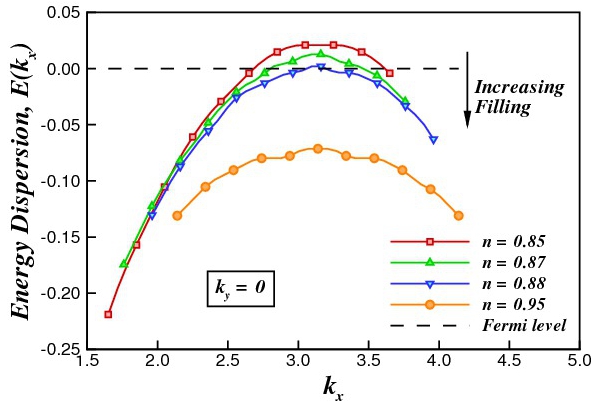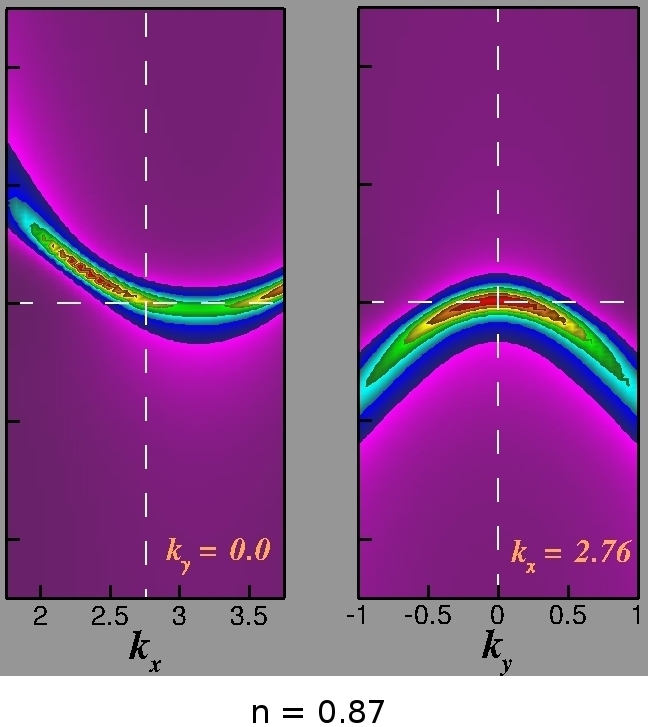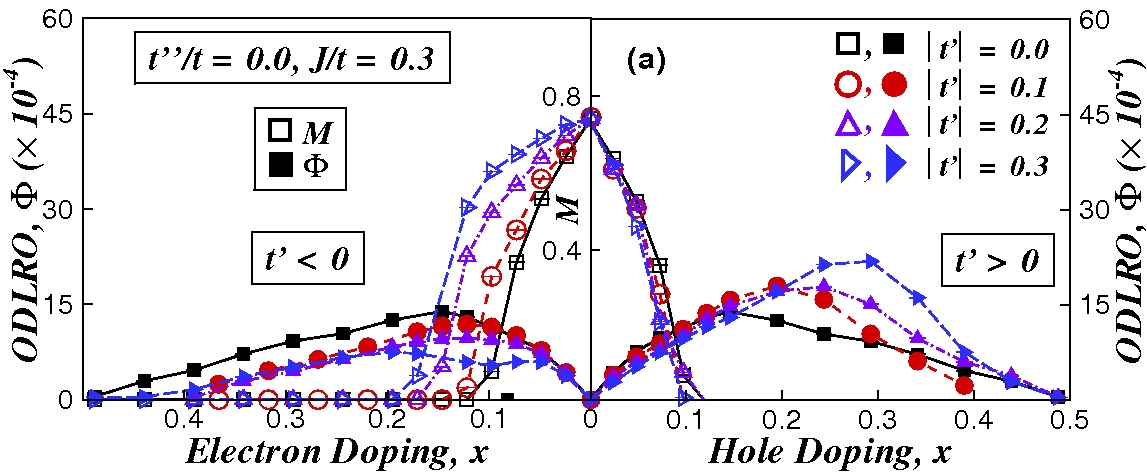RESEARCH OVERVIEW
Role of the van Hove singularity in the Quantum Criticality of the Hubbard model
(Phys. Rev. B 84, 245107 (2011))
A quantum critical point (QCP), separating the non-Fermi liquid region from the Fermi liquid, exists in the phase diagram of the 2D Hubbard model (Phys. Rev. Lett. 102, 206407 (2009)). Near the QCP, the real part of the bare d-wave p-p susceptibility exhibits algebraic divergence with decreasing temperature, replacing the logarithmic divergence found in a Fermi liquid (Phys. Rev. Lett. 106, 047004 (2011)). Also, a van Hove singularity (vHS) in the single particle dispersion crosses the Fermi level near the quantum critical filling. We explore the role played by this crossing in the quantum criticality of the Hubbard model.
We found that non-interacting models with vHS at Fermi level cannot completely describe the critical algebraic behavior of the real part of the bare d-wave p-p susceptibility. We also found that a negative next-near-neighbor hopping t' increases the doping region with marginal Fermi liquid character by studying the transport properties.


(left)
Dispersion along anti-nodal direction for various fillings, (right) the
vHS (flat region in the dispersion) crossing Fermi level at n = 0.87.
Application of the Dual Fermion-Dynamical Cluster approach to 1D Falicov Kimball model
The Falicov Kimball model is the
simplest model for correlated
electrons, introduced to study metal-insulator transitions. In one
dimension, it is known to possess a charge density wave (CDW)
instability at zero transition temperature (Tc). However, finite
cluster methods like Dynamical Mean Field Theory (DMFT), Dynamical
Cluster Approximation (DCA), Cellular Dynamical Mean Field Theory
(CDMFT) , etc. show finite temperature CDW transition. In this work, we
investigate the model using the recently developed Dual
Fermion-Dynamical Cluster approach (Phys. Rev. B 84, 155106 (2011))
that takes into account large length scale correlations through the
auxiliary particles known as dual Fermions. We find that (Tc) obtained
from this method is lower than that obtained from the cluster methods.
In particular, we study the scaling behavior of (Tc) with the linear
cluster size.
Possibility of the QCP in the Hubbard model (A VMC study)
The Dynamical Cluster method suggests
that there is a QCP in the Hubbard model at T=0, but this is inferred by
extrapolating finite temperature data to zero temperature as it is
exponentially hard to perform QMC calculations at low temperatures due
to the minus sign problem. Motivated by the physics intuition obtained
from the cluster methods, we aim at studying a general "normal" state resonating valence
bond
(RVB) wavefunction with enhanced antiferromagnetic correlations at T=0 as a function of doping.
Currently, I am leading a team comprising of physicists and computer
scientists to develop a massively efficient VMC code for this project
on the Graphical Processing Units
(GPUs) platform.
Ground state studies of extended t-J model
There have been many
unresolved questions in the area of high
temperature superconductivity
in cuprates in spite of great theoretical efforts. We have investigated

- asymmetry between electron and hole doping
- competition between antiferromagnetism (AFM) and d-wave superconductivity (SC)

Phase
Diagram of
extended t-J model showing Neel magnetization M
and the SC
order parameter as a function of both hole- and electron-doping[1]
FUTURE PROJECTS
Lifshitz Transition in the Hubbard model
There is a change in Fermi surface
topology from hole-like to electron-like associated with the vHS
crossing the Fermi level. This change in Fermi surface topology can
introduce Lifshitz
singularities in the free energy. This scenario will mean a line of
zero temperature critical points in the t'-chemical potential plane beyond
the quantum critical point as the control parameter t' is decreased from zero to
negative values in the t'-chemical
potential plane. We are working on developing a mean-field theory to
study such transition based on the physics intuition obtained from the
cluster studies.